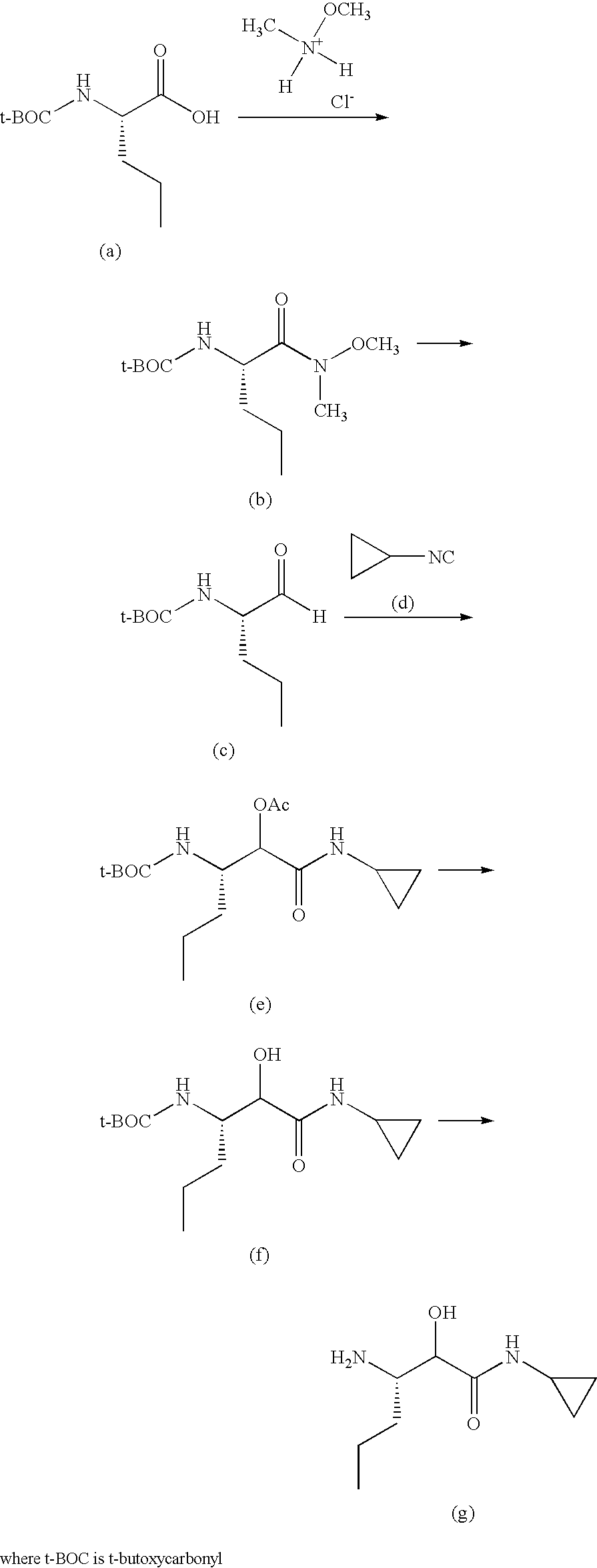Process for the preparation of (3S)-3-amino-N-cyclopropyl-2-hydroxyalkanamide derivatives
- Summary
- Abstract
- Description
- Claims
- Application Information
AI Technical Summary
Problems solved by technology
Method used
Image
Examples
example 1
Preparation of a Compound of Formula (3)
A. Preparation of (S)-benzyl 2-(dibenzylamino)pentanoate
[0073]
[0074]Sodium hydroxide (0.513 Kg; 12.82 moles) and potassium carbonate (1.77 Kg, 12.82 moles) were dissolved in water (7.5 L) and cooled to 0° C. The resulting solution was treated with (S)-2-aminopentanoic acid (L-norvaline, 0.75 Kg; 6.41 moles) slowly at between 0-5° C. The stirred suspension was heated at 90° C. and benzyl bromide (4.385 Kg, 25.64 moles) was added dropwise. Heating was continued for a further 12 hours at 90° C. The reaction mixture was then cooled to ambient temperature, and extracted with ethyl acetate (2×6 liters). The layers were separated and the aqueous phase extracted twice with ethyl acetate. The combined organic extracts were dried over sodium sulfate, and the solvent removed under reduced pressure to obtain 3.3 Kg of crude (S)-benzyl 2-(dibenzylamino)pentanoate, a compound of formula (3), as a brown oil. This material was used in the next reaction withou...
example 2
Preparation of a Compound of Formula (4)
A. Preparation of (S)-2-(Dibenzylamino)pentanoic acid
[0081]
[0082]The crude (S)-benzyl 2-(dibenzylamino)pentanoate (3) (2.2 Kg) was dissolved in methanol (5.5 L). A previously prepared, cold (0-5° C.) solution of sodium hydroxide (568 g; 14.2 mol) in water (6 L) was added to the solution of (3), and the resulting mixture heated at 90° C. for 20 hours. The reaction mixture was then allowed to cool to ambient temperature, and the methanol evaporated under reduced pressure. The residue was diluted with water (25 L), and extracted with methyl t-butyl ether / hexane (1:1; 2×5 L) to remove the benzyl alcohol formed in the hydrolysis. The basic aqueous layer was acidified to pH 2 with 6M aqueous hydrochloric acid (4 L), then extracted with ethyl acetate (2×8 L). The combined organic extracts were dried over sodium sulfate and the solvent removed under reduced pressure, to afford a semi solid, which was washed with hexanes (8 L) to provide 1.12 Kg of (S)...
example 3
Preparation of a Compound of Formula (6)
A. Preparation of (S)-2-(Dibenzylamino)-N-methoxy-N-methylpentanamide
[0089]
[0090](S)-2-(dibenzylamino)pentanoic acid (1.57 Kg; 5.286 mol) was dissolved in dry dichloromethane (9.42 L) under a nitrogen atmosphere and cooled to 0-5° C. The resulting solution was treated with N-hydroxybenzotriazole (HOBt; 928 g; 6.875 mol) followed by 1-ethyl-3-(3′-dimethylaminopropyl)carbodiimide (EDCI, 1.51 Kg; 7.931 mol;) at 0-5° C. The reaction mixture was stirred for 3 hours at ambient temperature, then treated with N-methylmorpholine (NMM; 1.62 Kg; 16.07 mol) followed by N,O-dimethylhydroxylamine hydrochloride (1.29 Kg; 13.22 mol) at 0° C. The reaction mixture was stirred at ambient temperature for 15 hours, then water (2.5 L) added, and the mixture stirred for 10 minutes. The organic layer was separated, washed with 1% aqueous hydrochloric acid, followed by saturated aqueous sodium bicarbonate, then brine solution. The organic phase was dried over sodium s...
PUM
| Property | Measurement | Unit |
|---|---|---|
| temperature | aaaaa | aaaaa |
| temperature | aaaaa | aaaaa |
| temperature | aaaaa | aaaaa |
Abstract
Description
Claims
Application Information
 Login to View More
Login to View More - R&D
- Intellectual Property
- Life Sciences
- Materials
- Tech Scout
- Unparalleled Data Quality
- Higher Quality Content
- 60% Fewer Hallucinations
Browse by: Latest US Patents, China's latest patents, Technical Efficacy Thesaurus, Application Domain, Technology Topic, Popular Technical Reports.
© 2025 PatSnap. All rights reserved.Legal|Privacy policy|Modern Slavery Act Transparency Statement|Sitemap|About US| Contact US: help@patsnap.com



